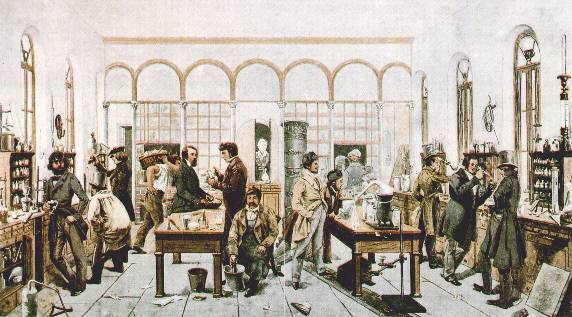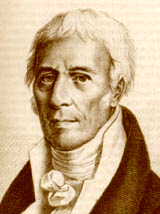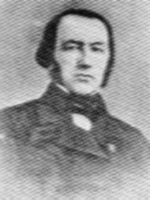
Liebig's Analytical Laboratory in 1840
Thanks to Liebig Museum in Giessen
The new idea of the living thing was of a set of components which belonged to a whole and which through their interactions preserved the integrity of the whole.
This idea takes shape in the work of Cuvier, approaching from the perspective of comparative anatomy. It was conceived in relation to the animal's gross parts - its organs and organ-systems.
At the end of the 18th Century a new understanding was developing of what underlay the gross structures, replacing the 18th Century notion of a congeries of particles moving about under the influence of a limited number of "forces". (Does Foucault perhaps just not know about this development?)
The new understanding grows out of the application of chemical analysis to substances
found in or produced by animals and plants. Chemical analysis showed what a
substance was made up of, and revealed the proportions of the various components
identified. It relied, as far as animal and plant substances were concerned,
to begin with on destructive distillation - heating the stuff and collecting
the various products; and then on what was in essence burning, but burning in
a way that permitted close control. The stuff to be analysed was heated with
what is known as an oxidising agent. (Burning is a fast sort of oxidation.)
Once again, the products of the oxidation process were collected and weighed.
The use of oxidising agents, developed to begin with by Lavoisier, revolutionised
the accuracy of analysis. Better and better agents were identified, until by
the 1830s analysis had been refined into a standard laboratory technique that
was reliable and accurate.
 |
|
Liebig's Analytical Laboratory in 1840 Thanks to Liebig Museum in Giessen |
In the first decade of the 19th Century therefore you have more and more substances found in living things being subjected to analysis:
Liebig's studies turned to organic analysis in the 1820s (William H. Brock The Fontana History of Chemistry London, 1992, Harper-Collins, p.202).
"Liebig's speedy, reliable method of [organic] analysis [established in the 1820s]... lead to a burst of activity and an immense clarification of chemical evidence: relationships between organic compounds could be seen for the first time and classifications of species became possible" (William H. Brock The Fontana History of Chemistry London, 1992, Harper-Collins, p. 208).
The picture begins to emerge, first, of the living thing as producing a range
of (now) organic substances, then as tantamount to a chemical laboratory, concerned
solely with the synthesis of chemicals; and in a third stage, as made up entirely
of the chemical substances it had itself produced.
 |
|
Lamarck Introduction to Lamarck provided by The Victorian Web |
The image of a chemical laboratory appears in the seminal Zoologie Philosophique of Lamarck as early as 1808, though he invoked it in connection with living bodies considered altogether:
"... the totality of living bodies may be regarded as an immense and ever active laboratory from which all existing compounds were originally derived"
and it appears clearly in the first textbook of botany authored by M.J. Schleiden in 1842.(Grundzuge der wissenshaftlichen Botanik. Translated into English in 1849 as Principles of Scientific Botany), Schleiden's influential work opens with an account of the chemical constitution of plants:
"Merely in content and arrangement, the difference from any previous general treatment of botany was startling. Almost no attention is given to the detailed systematics of higher plants, which, Schleiden complained, had formerly occupied botanists to the exclusion of far more important topics. Instead, the first chapter deals with the chemical constitution of plants, the main elements present, the chief classes of organic substance formed, the substances absorbed (carbon dioxide, water, ammonia) to form organic matter..." (A.G. Morton History of Botanical Science London, 1981, Academic Press, p. 378.)
"Botany is the science of the transformation of matter in the form of plants"
(M.J. Schleiden, cited by Morton, A.G. Morton History of Botanical Science London, 1981, Academic Press, p.412)
Beyond that, there arose the question of what happened to the chemicals once synthesised, a question that was answered with the thought that they must enter into chemical interactions with their neighbours. So the body becomes thought of not simply as a synthesiser and storehouse of chemicals, but as a configuration of chemical processes - and as simply a configuration of chemical processes. That was what an organic body was: that was what life was.
Wherever there was life there was a dynamic process, a network of on-going chemical processes which produced the appearance of persistent structure at the level of gross observation.
 |
|
Bernard Thanks to Founders of Neorology exhibition mounted by the University of Illinois |
The final component of this concept, that a the chemical plant is goal-directed, slips out quietly in the writings of Claude Bernard. It can only do so because the idea of a mechanism, to which no one wishes to attribute consciousness, nevertheless pursuing a goal has been made familiar by thought which had been established by the Romantics.
But the conception of the living thing as a producer of chemicals, and even the idea of a producer of chemicals that has produced its own body, does not in itself involve the idea that came to be definitive of the organism in the second half of the 19th Century and into the present day. This is the idea that the chemical laboratory that produced itself also ran itself: the idea of a configuration of complexly interacting chemicals so organised as to maintain its own persistence in time - its own 'integrity'.
Of course the question of integrity had been acknowledged as the chemical character of living things became clearer. Lamarck speaks of a special force acting in living things ' to harmonise their movements and maintain their integrity'.
But what takes shape finally in the work of Claude Bernard is the idea that it is the organisation of the chemical processes involved which is such as to maintain the complex in operation. The key feature of the organisation is that it is a circular one. The products of one process feed into the next, and the products of that one into the next. But because the processes are linked in a circle eventually the products of each process feed into itself. What you have here is the idea of 'feedback'.
In the twenties and thirties of the present century this idea is developed by
three biologists in particular, L.J. Henderson, Walter Cannon and Sherrington,
and it becomes the inspiration of a whole (at least would-be) orientation towards
the study of living things, 'organismic biology', linked with the names of von
Bertalanffy et al.
Henderson points back to the inspiration of Claude Bernard in this regard - bringing out an edition of Bernard's classic An Introduction to the Study of Medicine in 1927 - and certainly the idea of the organism as a system of chemical processes, closely interdependent, requiring the maintenance of a stable 'internal environment', is there, trenchant and clear, in Bernard's book of 1865.
'... in the case of the complex higher organisms, physiologists and physicians must study the stimuli of vital phenomena, not in the relations of the whole organism with the general cosmic environment, but rather in the organic conditions of the inner environment. Considered in the general cosmic environment, the functions of man and of the higher animals seem to us, indeed, free and independent of the physico-chemical conditions of the environment, because its actual stimuli are found in an inner, organic, liquid environment. What we see from the outside is merely the result of physico-chemical stimuli from the inner environment; that is where physiologists must build up the real determinism of vital functions."
Claude Bernard, An Introduction to the Study of Experimental Medicine First published 1865, Dover Edition, (a reissue of the English translation by H.C. Green published in 1927), New York, 1957, p. 79.
Here Bernard is positing the existence of the 'internal environment' for which he is famous, and he makes it clear that the chief role at any rate for the internal environment is the maintenance of a stable set of conditions required by the inner workings if they are to proceed smoothly.
But he is also concerned to explain how the myriad different inner processes that can be identified within an organism mesh in with each other so as to constitute, in effect, sub-processes, which together amount to a unitary process overall - a unitary overall process which is the life of the individual.
Commentators have attributed this function to the internal environment too. Coleman writes for example that
"The internal environment [for Bernard]... is largely responsible for that harmonious integration of myriad diverse physical and chemical events that take place in the organism"
(William Coleman Biology in the Nineteenth Century Cambridge 1977 CUP, p.157).
But to be found in Bernard himself is a slightly different formulation:
"... complex physiological phenomena are made up of a series of simpler
phenomena each determining the other by associating together or combining for
a common final object ... The ancient emblem representing life as a closed circle,
formed by a serpent biting its own tail, gives a fairly accurate picture of
things. In complex organisms the organism of life actually forms a closed circle,
but a circle which has a head and tail in this sense, that vital phenomena are
not all of equal importance, though each in succession completes the vital circle.
Thus the muscular and nervous organs sustain the activity of the organs preparing
he blood; but the blood in its turn nourishes the organs which produce it. Here
is an organic or social inter-dependence which sustains a sort of perpetual
motion, until some disorder or stoppage of a necessary vital unit upsets the
equilibrium, or leads to disturbance or stoppage in the play of the animal machine."
Claude Bernard, An Introduction to the Study of Experimental Medicine First published 1865. Dover edition, (a reissue of the English translation by H.C. Green published in 1927), New York, 1957, p.87,8.
For Bernard, the coherence of the life-process comes as a consequence of the interaction between sub-processes: the product of one sub-process, for example, altering the course of another, whose product in turn may play a role in determining the course, or vigour, of a third -which may in the same way have a bearing on the first - and so on.
So this seminal idea - the concept of a feedback-controlled physiological complex
- occurs in two contexts in the work of Bernard. There is the notion of a core
set of chemical processes maintaining themselves in continuing state as a result
of the way the processes are organised, and there is the notion that the immediate
environment of that core - the 'inner environment' - constituting a set of mechanisms
which serve to isolate the core from the viscissitudes of the external world,
for example by maintaining within close limits the ambient temperature around
the core, even though the external temperature may be varying widely. In both
contexts you have a system that maintains through feedback a steady state in
the face of perterbations.
This concept of Bernard's, drawn on by Henderson and colleagues later, is particularly
interesting from the philosophical point of view because it is teleological
in character. If we call the living thing, from the point of view which identifies
it with a complex of interacting physiological or chemical processes, an organism
, then Bernard's organism is teleological because it has a goal: continuation
of process. The component sub-processes in an organic organisaton 'determine
each other' says Bernard 'for a common final object' (citation above). And the
overall common final object is the perpetuation of the complex, the continuing
'functioning' of the organism.
This is a conception of 'life' that was not there fifties years earlier, in Lamarck's Zoologie Philosophique, for example, published originally in 1809, which encapsulated, and was widely recognised as encapsulating, the state of scientific thinking about animals and plants of the time. Lamarck:
Zoological Philosophy. First Published as Zoologie Philosophique,
1809, English Tranlation by Hugh Elliot, Hafner Publishing, New York and London,
1963)
Credits
Lamarck portrait courtesy The Victorian Web